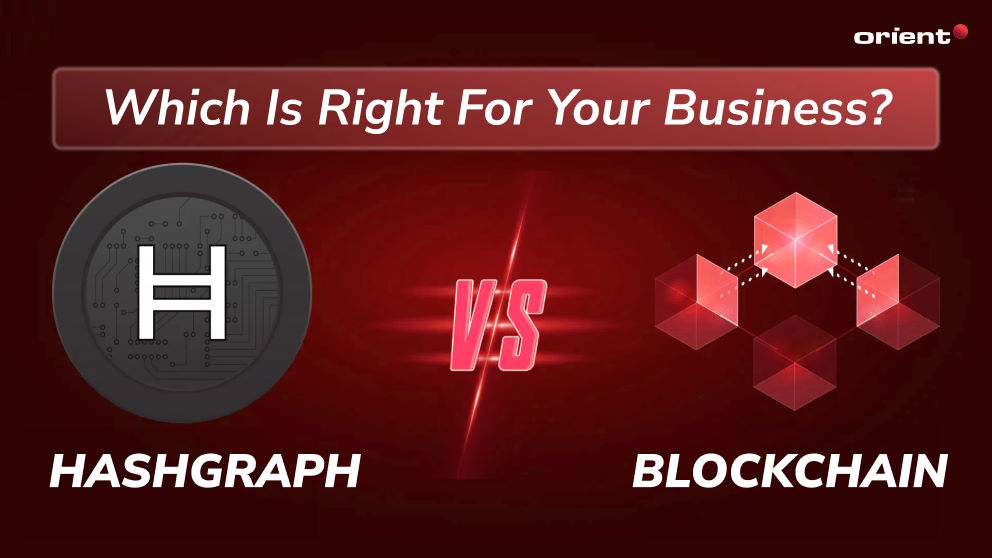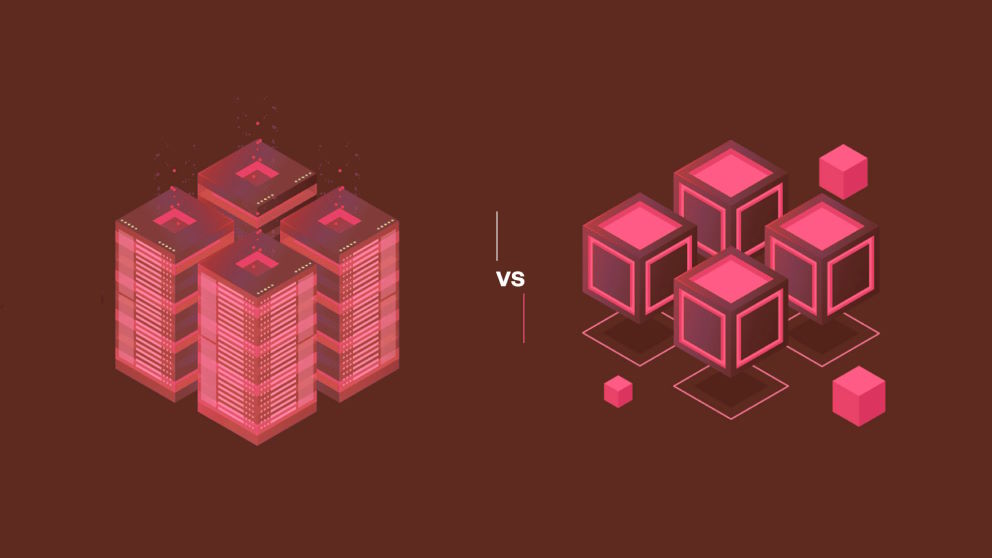
Hashgraph Vs. Blockchain: Which is Right for Your Business?

Content Map
More chaptersIn the fast-moving digital world of cryptocurrency and blockchain technology, staying ahead with the latest advancements is crucial to making the most of your decentralized solutions.
While blockchain has been the dominant distributed ledger technology (DLT) for nearly 15 years now, there are many competitors out there aiming to address the shortcomings of blockchain and promising a better solution. One of the biggest up-and-comers is Hashgraph, a blockchain alternative that promises to deliver fast transaction speed, increased efficiency, and a more comprehensive security solution.
In this article, you’ll find out what Hashgraph and blockchain are, how they work, their similarities and differences, and how to choose the right technology for your business.
What Is Blockchain?

Blockchain is a type of DLT that stores data in a database as a series of “blocks” linked together, forming a chain. The data contained within these blocks can be shared with others through the peer-to-peer communication protocol. The main calling card of the blockchain is that once data has been written and recorded, it cannot be deleted or modified by anyone. This makes it virtually unviable for threat actors, both internal and external, to access the blockchain and alter, remove, or reverse the state of the data contained inside.
The blockchain is the underlying technology powering many cryptocurrencies, including Bitcoin and Ethereum. These currencies aim to provide a decentralized alternative to traditional methods of financial management, eliminating the need to rely on a select few financial institutions to collect, manage, and process currency.
What Is Hashgraph?

Hashgraph is an alternative DLT to blockchain. Unlock blockchain, which stores data (as a series of transactions) in blocks, hashgraph uses systems called “gossip about gossip” and virtual voting to store and verify data in the database. The main purpose of hashgraph is to overcome the limitations of blockchain, aiming to provide faster transaction processing speeds, reduced transaction fees, and higher levels of security through a proprietary system called aBFT (Asynchronous Byzantine Fault Tolerance).
Gossip about gossip and virtual voting are two systems unique to hashgraph, which collectively aim to verify the authenticity of data stored in its database. It achieves this by having the nodes within the database share information with each other, and every instance of new information shared with a specific node will result in that information being shared much faster with the rest of the nodes than previously. Each “gossip” message contains specific details inside, including a timestamp, a digital signature, and cryptographic hashes (a type of encryption).
What Are the Similarities and Differences Between Hashgraph and Blockchain?

Although both hashgraph and blockchain are two competing DLTs, they do share similar DNA. This is understandable, as hashgraph was initially created as a means to improve upon the already existing blockchain framework.
Therefore, it’s understandable that the two operate in similar ways, even if their underlying features and workflow come from two completely different ways of thinking. That said, let’s look at some of the ways that hashgraph and blockchain are similar.
Both Are Types of DLTs
Both hasgraph and the blockchain are types of distributed ledger technologies. Similar to a distributed enterprise, they are spread across geographic locations. That is, they both rely on a peer-to-peer network to communicate, transmit data, and reach a consensus on specific requests and commands. They are also strong proponents of decentralization, eliminating the reliance on any one given provider or system to function.
Both Can Verify and Authenticate Transactions
The ability to verify and authenticate a transaction is a vital component of a DLT. Fortunately, both hashgraph and the blockchain have unique verification processes.
While the two approach the process in different ways, the intended outcome is ultimately the same: To ensure that a transaction occurring between two different nodes is correct. This aids in the user verification process, ensuring that a user’s identity is actually who the node says it is, thus preventing fraudulent activity.
Both Have Systems to Ensure Fairness
What does it mean for a DLT to have a “fair” system? Put simply, it means that the DLT offers a level playing field where each user has the same opportunity (and level of authority) to contribute to the system.
Both hashgraph and the blockchain promote fairness in their systems, albeit in different ways. Essentially, both systems are designed to ensure that, regardless of the order in which a transaction occurs, no one person is negatively impacted by the transaction order.
How Does Hashgraph and Blockchain Differ?
Despite both being examples of DLTS, many core elements set the two technologies apart. Both the blockchain and hashgraph have different approaches when it comes to managing security, transaction processing, establishing consensus mechanisms, and code availability. Let’s take a closer look at these differences in detail.
Security
Both hashgraph and the blockchain have a different approach to creating a secure environment. The blockchain uses the cryptographic method, which involves using a specific mathematical algorithm to validate data. It is also designed to protect a user’s confidentiality, integrity, and authenticity. More importantly, if a user tries to tamper with a digital block on the blockchain, the system triggers an alert to the nodes, which the user can then monitor and act upon.
Meanwhile, hashgraph uses a feature called zBFT (Asynchronous Byzantine Fault Tolerance), which protects the network from threat actors by recording each event that occurs on the network. This enables the system to compare past versions of data, alerting the system and user to data discrepancies.
Which approach is right for you? That depends on your unique security requirements. When you approach Orient Software for a project, one that requires either hashgraph or blockchain software development, we can assess your security needs and recommend a software solution that best fits your needs.
Transaction Processing Speeds
Although the security features of both hashgraphs and the blockchain are similar, their processing speeds differ considerably. This is because, as of the time this is being written, hashgraph is a much faster platform than the blockchain. How much faster? Let’s compare the two.
On average, hashgraph can process up to 500,000 transactions per second, which is a heck of a lot of power. This is made possible by the fact that hasgraph uses the “gossip” method to maintain connectivity, which is much faster than the blockchain using miners to validate transactions. By comparison, the blockchain can process up to 10,000 transactions per second.
So you see, hashgraph is much faster at processing transactions than the blockchain. Therefore, if faster transaction speeds are your ultimate goal here, then hashgraph is your DLT of choice.
Consensus Algorithm
Both Hedera hashgraph and the blockchain have different approaches to reaching a consensus. Hashgraph uses a concept known as virtual voting to gain a consensus on the network. It is essentially a consensus algorithm, one that eliminates the need for votes to be sent among the network to calculate the votes of each member and instead has members calculate votes by looking at each copy of the hashgraph across the system. This approach helps save bandwidth and ensures that each member votes based on the same rules.
Meanwhile, the blockchain doesn’t have a unified approach to establishing a consensus. Instead, the approach is different based on the choice of platform or cryptocurrency. Examples of network consensus algorithms in the blockchain include Proof-of-Work (where one party proves to others, via smart contracts, that they have exhausted their computational efforts) and Proof-of-Stake (where one party proves that they have contributed something of value to the network). The right consensus protocol depends on the cryptocurrency or platform and the client’s unique requirements.
Read more: Private vs Public Blockchain: How Do They Differ?
Code Availability
This is one area where the two DLTs are very different. This is because the blockchain is entirely open source, available to the public to modify and use as anyone pleases. It also has a strong community-driven support group, where developers, miners, and other stakeholders contribute to the success of a blockchain software development project. This is one of the reasons why the blockchain has been able to thrive in the first place – thanks to its dedicated community.
Hashgraph, on the other hand, is a patented technology that is entirely owned and operated by Hedera, the company that created it. This severely limits what users can do with the platform, as they’re at the mercy of the developer to add new features, correct bugs and issues, and make other quality-of-life improvements. If customization is important to your cryptocurrency or other DLT projects, then hashgraph may not offer the flexibility you are looking for.
At Orient Software, we are highly skilled in adapting to the unique requirements of clients for both blockchain and hashgraph projects. If you want to utilize the open-source capabilities of the blockchain, then we can accommodate you by providing custom software, integrations, and other enhancements. If, however, you would rather stick to the hashgraph ecosystem with a proven solution, then our team can develop it based on your requirements.
How to Choose the Right Distributed Ledger Technology for Your Business
By now, you should have a deep understanding of hashgraph and the blockchain, not just how they are similar but also how they are so different from each other. Can hashgraph replace blockchain? That depends on your needs. You should also get up to speed with the best blockchain platforms, which will get you up to speed on the different cryptocurrencies out there.
With this knowledge, you’ll be able to choose the right platform for your project. However, if you need a quick refresher to get you up-to-speed, here is a simple breakdown of when to choose which platform.
Choose Hashgraph If You Want a DLT That Offers
Superior Transaction Processing Speeds
With an average speed of 250 to 500,000 transactions per second, hashgraph is the platform of choice for speed and efficiency.
Reduced Environmental Footprint
Mining the blockchain is a huge resource- and energy-intensive process, consuming approximately 173.42 TWh of electricity between 2020 – 2021. Hashgraph, on the other hand, does not use mining to verify transactions, making it the greener and more energy-efficient option.
Effective Security Measures, Particularly Against DDoS Attacks
Hashgraph has a variety of robust security measures, particularly when it comes to preventing DDoS attacks. This is because the system does not give any one node extra rights or authority over other nodes. With the blockchain, though, hackers can flood a major Bitcoin miner with packets to temporarily disconnect them from the internet, disrupting the entire hashgraph network.
Choose Blockchain Technology If You Want a DLT That Offers
A large Open-source Community
If being able to customize your distributed ledger technology is important to you, then the blockchain is the platform of choice. It has a strong, constantly growing, and thriving user community, with the opportunity for you to customize your platform to meet your unique requirements. There are many open-source projects out there, such as Corda, Quorum, and Openchain, which significantly change and enhance how blockchain solutions operate.
Data Structure Verification Through Mining
If cryptocurrency mining is important to your project, then blockchain platforms will enable you to conduct this practice. Hashgraph, on the other hand, does not utilize mining to verify and authenticate transactions.
Complete Transparency for Each Transaction
The blockchain is one of the most transparent DLTs around. It’s possible to monitor the status of every transaction with real-time insight into each digital block, providing you with user details, time and status, and other key information.
Kickstart Your Cryptocurrency or DLT Project With Orient Software
Regardless of whether you choose hashgraph or the blockchain for your project, Orient Software is here to help.
Ever since the early days of the blockchain, our team has been hard at work staying up to date with the latest developments, offering DLT solutions to clients across a range of industries, from cryptocurrency and supply chain management to identity management and many more. Most recently, we helped a Hong Kong-based business develop a website to help connect thousands of users worldwide on the blockchain market. With our long-standing history of supporting distributed ledger technology, we have the skills, knowledge, and capabilities to deliver a custom-made solution that meets your unique needs.
Our blockchain development services are second to none, incorporating both blockchain consulting and strategy and blockchain development into our offerings. If you have a business idea (that involves the use of the blockchain) and need advice, or you need a minimum viable product (MVP) to test the potential of your blockchain project, then come talk to us. Our top experts will be happy to discuss your project in greater detail and ascertain how our services can help bring your blockchain project to life.
For more information about our blockchain development services, contact us today.






